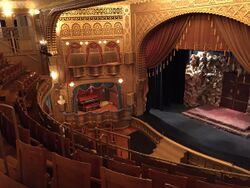Physics:Acoustic space
From HandWiki
Short description: Acoustic environment in which sound can be heard by an observer

Acoustic space is an acoustic environment in which sound can be heard by an observer. The term acoustic space was first mentioned by Marshall McLuhan, a professor and a philosopher.[citation needed]
Nature of acoustics
In reality, there are some properties of acoustics that affect the acoustic space. These properties can either improve the quality of the sound or interfere with the sound.
- Reflection is the change in direction of a wave when it hits an object. Many acoustic engineers took advantage from this. It is used for interior designs, either use reflections for benefits or eliminates the reflections. The sound waves usually reflect off the wall and interfere with other sound waves that are generated later. To prevent sound waves reflecting directly to the receiver, a diffusor is introduced.[1] A diffusor has different depths in it, causing the sound to scatter in random directions evenly. It changes the disturbing echo of the sound into a mild reverb which decays over time.
- Diffraction is the change of a sound wave's propagation to avoid obstacles. According to Huygens’ principle, when a sound wave is partially blocked by an obstacle, the remaining part that gets through acts as a source of secondary waves.[2] For instance, if a person is in a room and shouts with the door open, the people on either side of the hallway will hear it. The sound waves that left the door become a source then spread out in the hallway. The sounds from the surroundings might interfere with the acoustic space like the example given.
Uses of acoustic space
The application of acoustic space is very useful in architecture. Some kinds of architecture need a proficient design to bring out the best performances. For example, concert halls, auditoriums, theaters, or even cathedrals.[3]
- Concert Hall – a place that is designed to hold a concert. A good concert hall usually holds around 1700 to 2600 audience.[4] There are three main attributes of a good concert halls: clarity, ambiance, and loudness.[1] If the seats are well positioned, the audiences will hear clear sound from every single seat. For more ambiance, reverberation times are designed as preferred. For instance, romantic music usually requires an amount of reverberation time to enhance the emotions, therefore, the ceilings of the concert hall should be high.
Scratch Messiah 2015 at Royal Albert Hall, Kensington, London, United Kingdom - Theater – a place that is designed for live performances. The first priority for sound design in a theater is speech.[1][4] Speech has to be heard clearly, even if it is a soft whisper. The reverb is not needed in this case, it interrupts the words spoken by the actors. The intensity has to be increased, in order to enlarge the acoustic space, to cover the theater without disrupting the dynamic. In large theaters, amplification must be used.

- Cathedral (and church) have an area called a choir, usually located near the transept, where the tower is located in most cathedrals. The choir is for the choir to sing. This kind of singing needs a soft cloudy sound for ambiance and emotion. The height of the cathedral does not only show religious pride but also improves the acoustics. There is more reverb when the source generates a sound in the space

See also
References
- ↑ 1.0 1.1 1.2 Knudsen, V.; Harris, C. (1950). Acoustic Designing in Architecture. The American Institute of Physics. pp. 1–18, 112–150.
- ↑ Smitthakorn, P.; Siebein, G. (2012). Diffuse Reflection: Architectural Acoustics Effects of Specular & Diffuse Reflections on Perceived Music Quality. Saarbruecken, Germany: Lap Lambert Academic Publishing. pp. 11–19.
- ↑ Cavanaugh, W.; Tocci, G.; Wilkes, J. (2010). Architectural Acoustics Principles and Practice. In Marshall, L. (ed.) Acoustical Design: Places for Listening. New Jersey: John Wiley & Sons. pp. 133–157.
- ↑ 4.0 4.1 Long, M. (2006). Architectural Acoustics. In Levy, M. & Stern, R. (ed.) General Consideration: Design of Rooms For Music. The United States of America: Elsevier Inc.. pp. 653–656.

